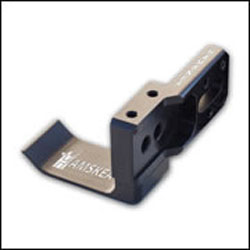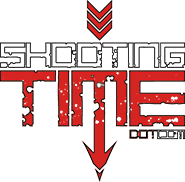By Tim “the Hammer” Gillingham
Over the course of your archery experience you may have come in contact with many opinions on many subjects and you will probably have various reactions to them. Most people take things repeated over and over again as the gospel and it seems the more it gets repeated the more it gets entrenched into our psyche.
You may have heard “ Overdraws make the bow more critical!” I tend to disagree and let me explain myself.
First I must give credit to the person that first brought the topic up in the first place. Many know world renowned professional archer Jesse Broadwater. Arguably one of the best archers the world has ever seen and probably the very best in the world today. He showed up on the scene a few years ago shooting an overdraw and many wanted to know why. Now I personally had been shooting an overdraw for many years for other reasons like being able to cut my arrow shafts shorter to lighten them up and make them stiffer. I had never seen a loss in accuracy so I continued to shoot my setups very successfully with about a 2” overdraw. When Jesse started talking about what he was doing I decided it was time to run my own tests and really try and figure out if indeed an overdraw was more forgiving.
People were talking about “Torque Tuning” their bows and a friend of mine was convinced that the perfect spot on my particular bow for the rest was ¾” from the throat of the grip. After much testing an analysis, this is what I found and it was not exactly what he had thought. The perfect spot for my rest was right where I had it with a 2” overdraw.
Results of torquing a compound bow
Torquing problem
Two things happen when we torque the bow; we are moving the sight one way and the arrow the opposite. The reason we get an impact change due to torque is that we are making compensations with the sight when we torque the bow and therefore the arrow is going to hit off line.
Torquing Solution
If we can put the arrow rest in the right position, we can find the “sweet spot” where the two actions (moving the sight one way and the arrow the opposite direction) cancel each other out. In layman’s terms, this means I can set the rest and sight position to a point that no matter how I torque the bow left or right, as long as the sight is on target the arrow will hit in the middle where I am aiming.
How to torque tune a compound bow
Usually what has to happen in most setups is that the rest has to come back and the sight may have to be moved forward or back to fine tune it. The rest is the primary adjustment because it is close to the nocking point and therefore less of a movement at the rest will make more of a change downrange. Here are the steps:
- Sight your bow in at 20 yards to start with.
- Draw the bow with and arrow, torque the riser to the left(arrow getting closer to the cable), put the pin in the middle and fire the shot.
- Draw the bow with another arrow and torque the bow the opposite direction to the right( arrow getting further away from the cable), put the pin in the middle and fire a shot.
- If the bow is perfectly torque tuned, all the arrow will hit in a tight group. If not, you will see a lateral spread in the arrows. Typically the arrow you torqued to the left( arrow getting closer to the cable)will impact to the right and the one torqued to the right(arrow getting further away from the cable) will impact to the left.
- Make adjustments to the rest, usually you have to bring the rest back incorporating the Hamskea Overdraw in conjunction with your Hamskea Versa Rest and/or move the sight forward. You will be amazed at the difference when you start playing with the rest position.
- Once you get the arrow impacting very close at 20 yards no matter what left or right torque you put on the riser, move back to 50 yards or further and repeat the test. You may have to make fine adjustments.
You can also move the sight in or out if that is an available option to you and that will allow some fine tuning also. It has less of an effect than the rest due to its position further away from the nocking point. Once you get this done you will be amazed at how much better your bow will shoot.
Torque tuning a bow – Rest side pressure
One of the other factors that I ran into in this experiment was that the launcher on the arrow rest needed to provide side support. It is one of the major reasons that the Accu-Glide launcher is designed the way it is to provide side support and correction to the arrow on a torqued shot. I found that while testing a skinny carbon shaft on a wide launcher, that no matter what adjustments I made I could not get the torqued shots to come together. A simple upward bend of the side of the launcher to provide side support solved the issue and that setup torque tuned exactly the same as other setups out of the same bow with a different arrow.
Where this will benefit you most as an archer or bowhunter is when you place your hand in the bow incorrectly or when you are shooting in the wind and making compensations to keep your sight on target as you are being blown around. On high let off bows that are easier to torque you will see a bigger benefit also but you should strive to always make the setup as forgiving as possible especially if it is just a small adjustment of the addition of an overdraw to your setup. In general I think it will make your bow shoot much more forgiving and make you a better archer. So get yourself a new Hamskea Overdraw and Versa rest combination and supertune your setup in more ways than one.
Torque tuning a bow – Benefits of shooting an overdraw
 The NEW! Hamskea Overdraw will fit your Hamskea Versa rest perfectly and lock to the riser to ensure it will never come loose at the moment of truth. Truly the most durable rest setup on the mark.
The NEW! Hamskea Overdraw will fit your Hamskea Versa rest perfectly and lock to the riser to ensure it will never come loose at the moment of truth. Truly the most durable rest setup on the mark.- Allows you to shoot lighter arrows
- Shorter arrows mean you can a lot of times drop to a lighter weight and spined shaft
- Shorter arrows mean less wind drift and more FOC for better forgiveness and long range performance
- Lighter arrows mean you can shoot larger diameter shafts for ASA 3-D or faster shaft in bigger diameters for IBO tournaments
- Shorter, stiffer shafts will fly broadheads much more accurately and are much more quieter in the quiver and more portable in the field
I hope my torque tuning tips will help you become a better archer and bowhunter!
